Darasuram Airavatesvara Temple: 12th Century Architectural Marvel
The Darasuram Airavatesvara Temple in Kumbakonam stands as a resplendent testament to the awe-inspiring beauty of South Indian architecture. Revered as one of the most significant Shiva temples in Tamil Nadu, it exudes an air of grandeur that leaves visitors spellbound. This sacred sanctuary is a hallowed tribute to Lord Shiva, renowned for its intricate carvings that seem to breathe life into stone, its breathtaking sculptures that transport you to another realm, and its storied past that echoes through the ages.
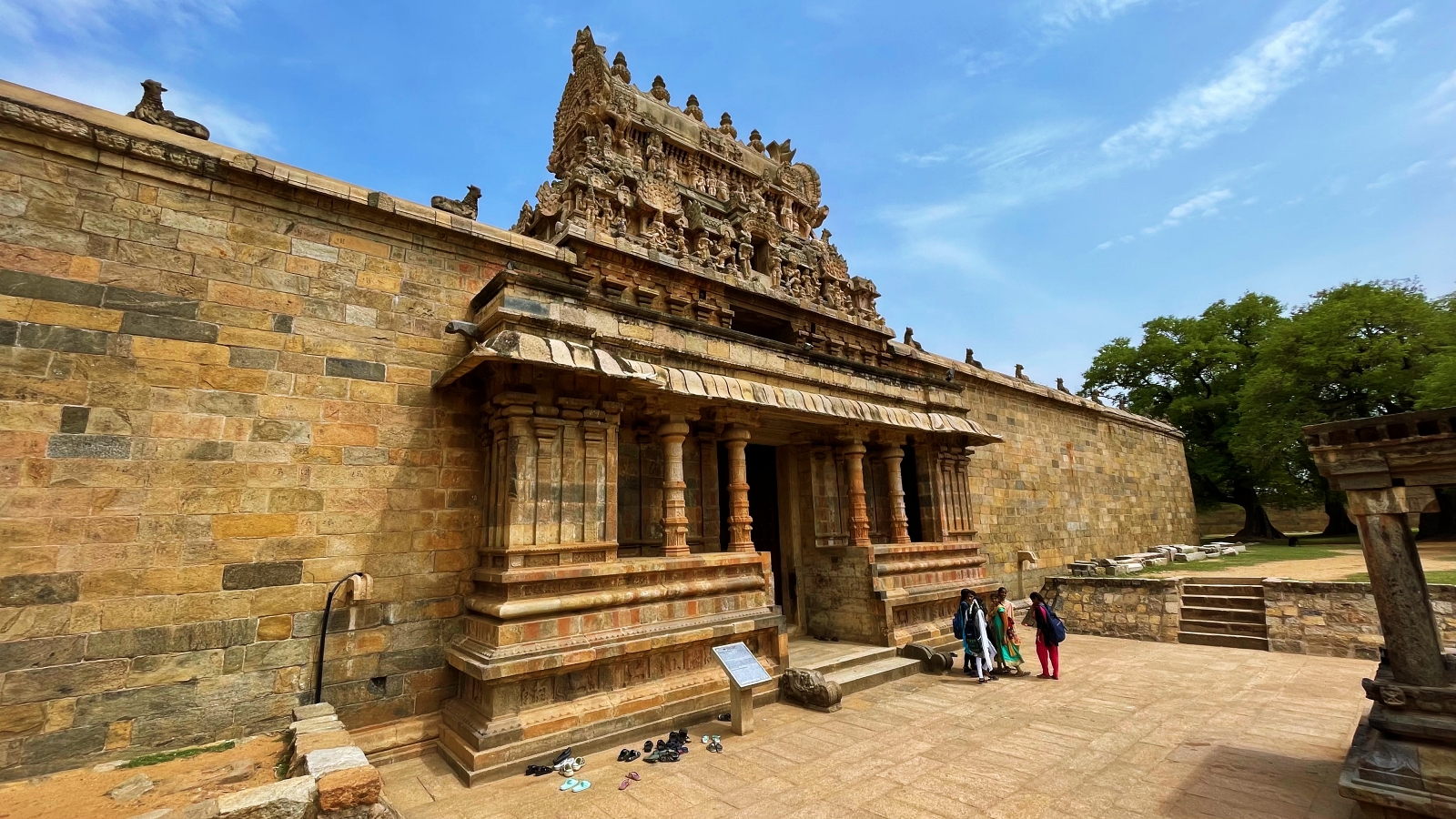
Brace yourself, for within the depths of this comprehensive guide, we shall embark on a captivating journey, unravelling the enigmatic facets of the Airavateswara temple. From delving into its rich history and marvelling at its architectural marvels, to immersing ourselves in the sacred rituals and vibrant festivals that grace its hallowed grounds, prepare to be enthralled by the sheer magnificence that awaits.
Table of Contents
History of the Airavatesvara Temple
In the 12th century, under the reign of the mighty Rajaraja Chola II, the Airavatesvara Temple emerged as a testament to the unrivalled architectural brilliance of the Chola dynasty. This awe-inspiring sanctuary, named after the celestial white elephant of Lord Indra, Airavata, was initially known as Periya-Koyil. However, its grandeur and significance demanded a more fitting title, thus it was later bestowed with the name Airavatesvara Temple. This sacred complex, standing tall and resolute, has defied the relentless passage of time.
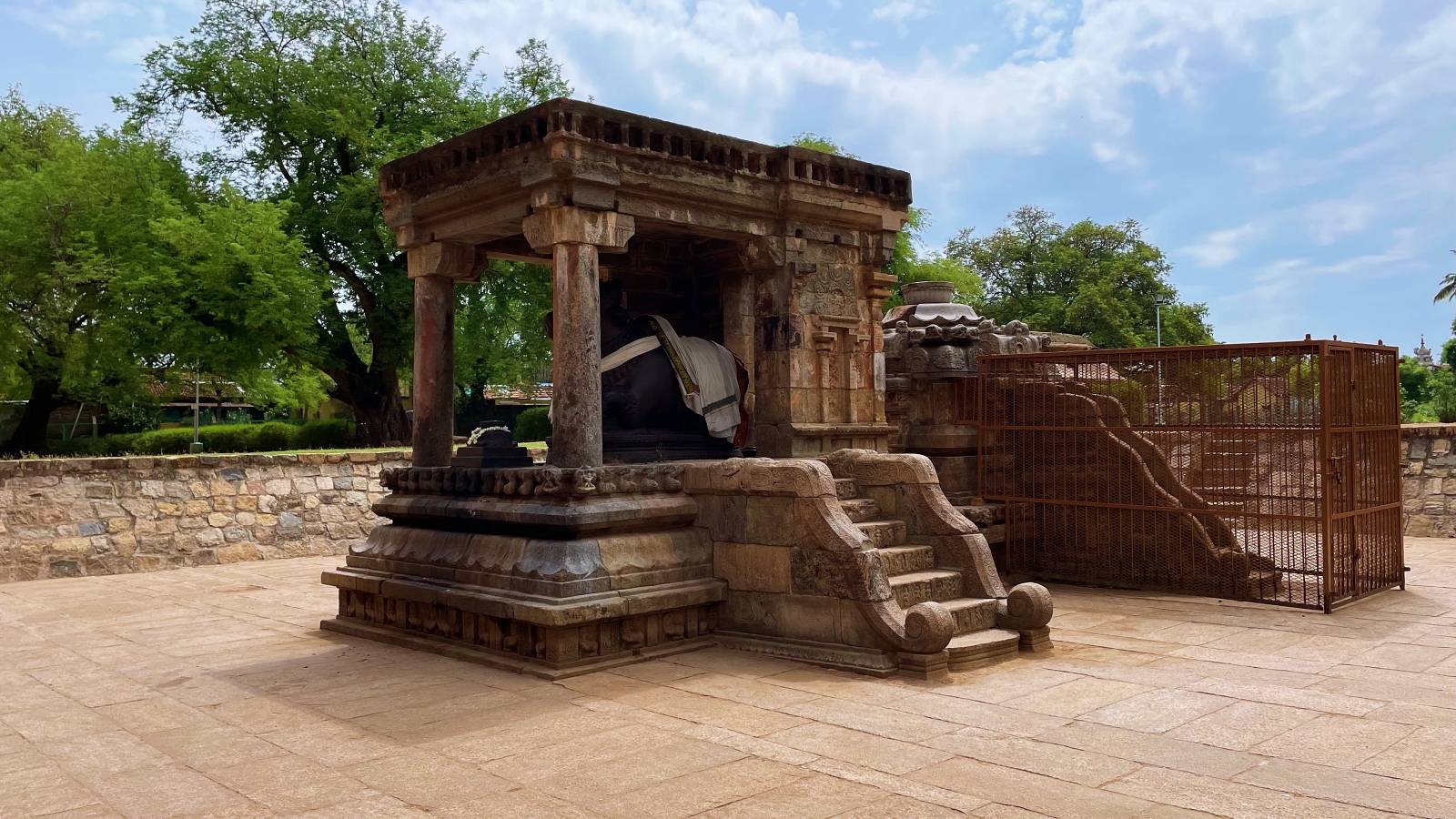
Its very existence serves as a testament to the indomitable spirit and ingenuity of the Chola kingdom. The Airavatesvara temple stands as a beacon of magnificence, captivating all who lay eyes upon its majestic form. Within its hallowed walls, one can feel the weight of history, as if the very stones whisper tales of ancient glory. The temple’s intricate carvings and exquisite craftsmanship transport visitors to an era long gone, where art and devotion intertwine to create something truly extraordinary. As you step into this sacred abode, the air becomes charged with an ethereal energy, as if the gods themselves have blessed this place with their divine presence.
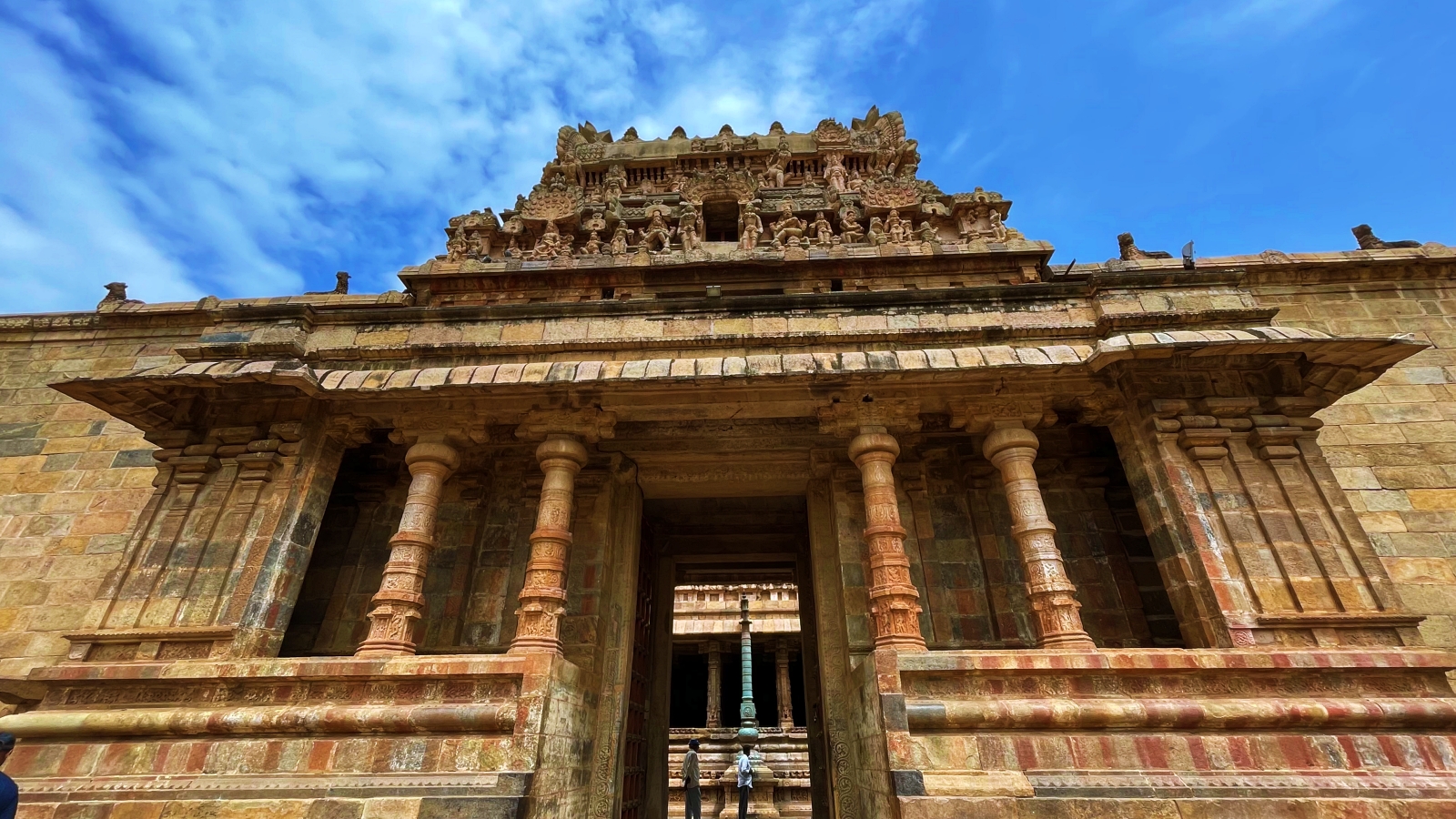
The temple’s sanctum, adorned with ornate sculptures and adorned pillars, exudes an aura of reverence and tranquillity. The Airavateswara temple is not merely a structure of stone and mortar; it is a living testament to the artistic prowess and unwavering dedication of the Chola dynasty. It stands as a reminder of the heights humanity can reach when driven by passion and a relentless pursuit of perfection. So, venture forth and let its ancient walls whisper their secrets, and allow yourself to be transported to a time when kings ruled with an iron fist and art flourished in all its resplendent glory.
The Airavatesvara temple, once a grandiose marvel, now stands as a mere shadow of its former glory. In its heyday, this architectural masterpiece boasted sapta veedhis, seven majestic streets, and seven resplendent courts, reminiscent of the renowned Srirangam temple. Alas, the ravages of time have mercilessly erased all but one court, where the main temple valiantly clings to existence. As one wanders through the temple grounds, the remnants of gopurams and scattered structures bear witness to the desolation that befell this sacred site. It is a haunting reminder of the catastrophic damage suffered by other illustrious Chola-era temples and the once-thriving Chola cities, including the mighty capital of Gangaikonda Cholapuram.
The echoes of a bygone era resonate through the air, whispering tales of grandeur and opulence that once graced these hallowed grounds. The temple’s decline serves as a poignant testament to the impermanence of human achievements, a stark reminder that even the mightiest structures can succumb to the relentless march of time. Yet, amidst the ruins, a glimmer of hope remains. The surviving court, with its majestic main temple, stands as a testament to the indomitable spirit of the Chola dynasty.
It is a beacon of resilience, a symbol of the enduring legacy left behind by those who came before us. As we stand in awe of the Airavatesvara temple, let us not only marvel at its faded splendour but also reflect upon the lessons it imparts. May it serve as a reminder that our own endeavours, no matter how grand or monumental, are fleeting moments in the grand tapestry of history.
Darasuram, a UNESCO World Heritage Site
Darasuram, a UNESCO World Heritage Site located in Airavateswara Temple complex, is a temple with a fascinating legend behind it. The story goes that Airavata, Lord Indra’s beautiful white elephant with four tusks and seven trunks, was cursed by Sage Durvasa for disrespecting him. Airavata had torn a garland of heavenly fragrant flowers from his head and trampled it into the dust, which angered Durvasa and led to him cursing the elephant with severe skin discolouration. Distressed at the loss of his beauty, Airavata went to Shiva for help. Shiva advised him to take a dip in the sacred waters of a healing pond at Darasuram, which restored the elephant’s blemish-free white colour.
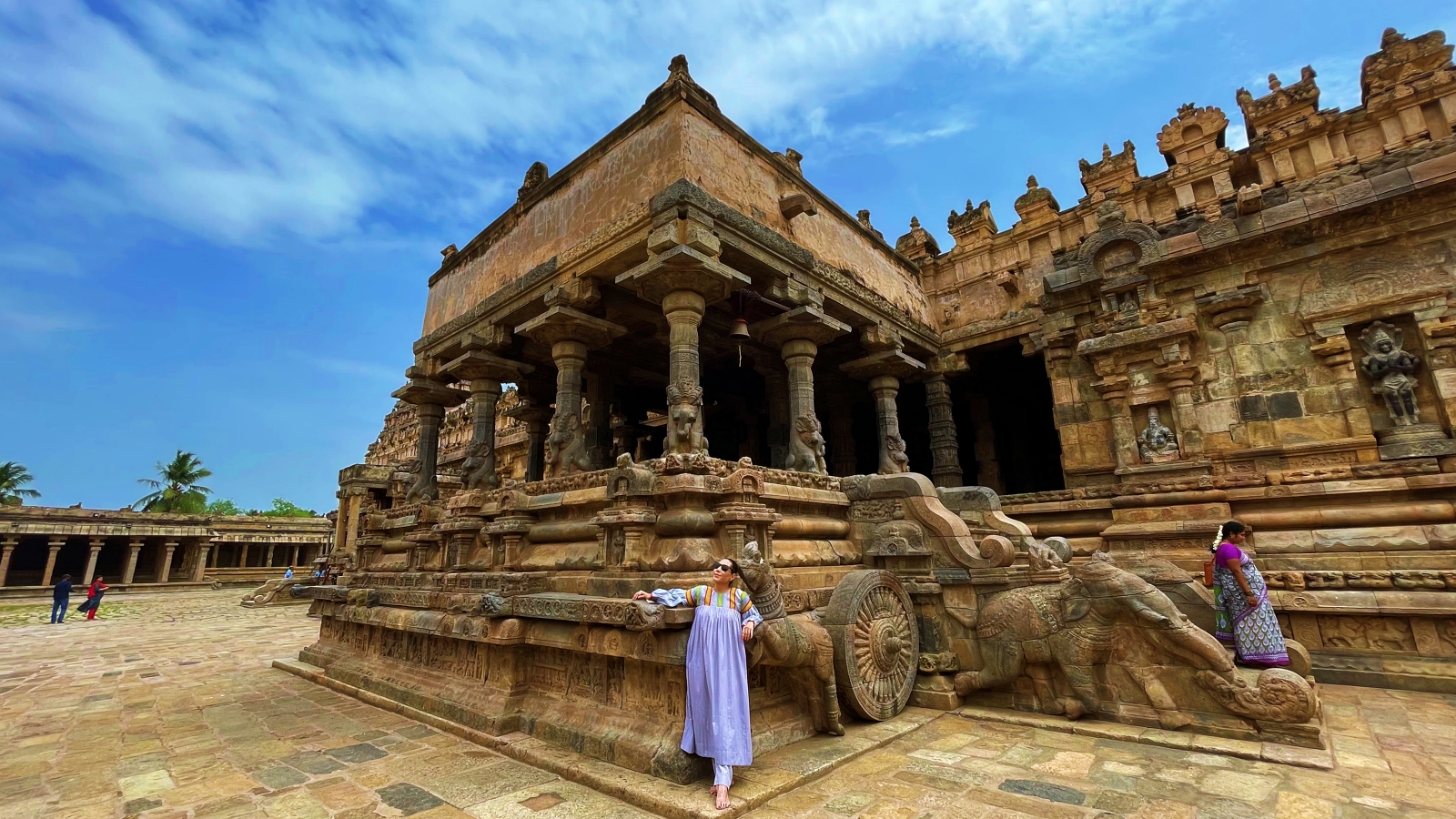
The pond became holy, and to commemorate this healing, Raja Raja Chola II, son of Rajendra Chola, built a temple at Darasuram. Over time, Darasuram was covered by the earth and was only recently rediscovered by the Archaeological Survey of India. The Airatesvara temple, built in the form of a chariot, is one of the marvels of South India and offers intricate carvings throughout the temple. It is also one of the few optical illusion temples, with reverse images carved on the granite. The temple is dedicated to Lord Shiva and is said to be the absolute masterpiece of Chola architecture and stone carvings.
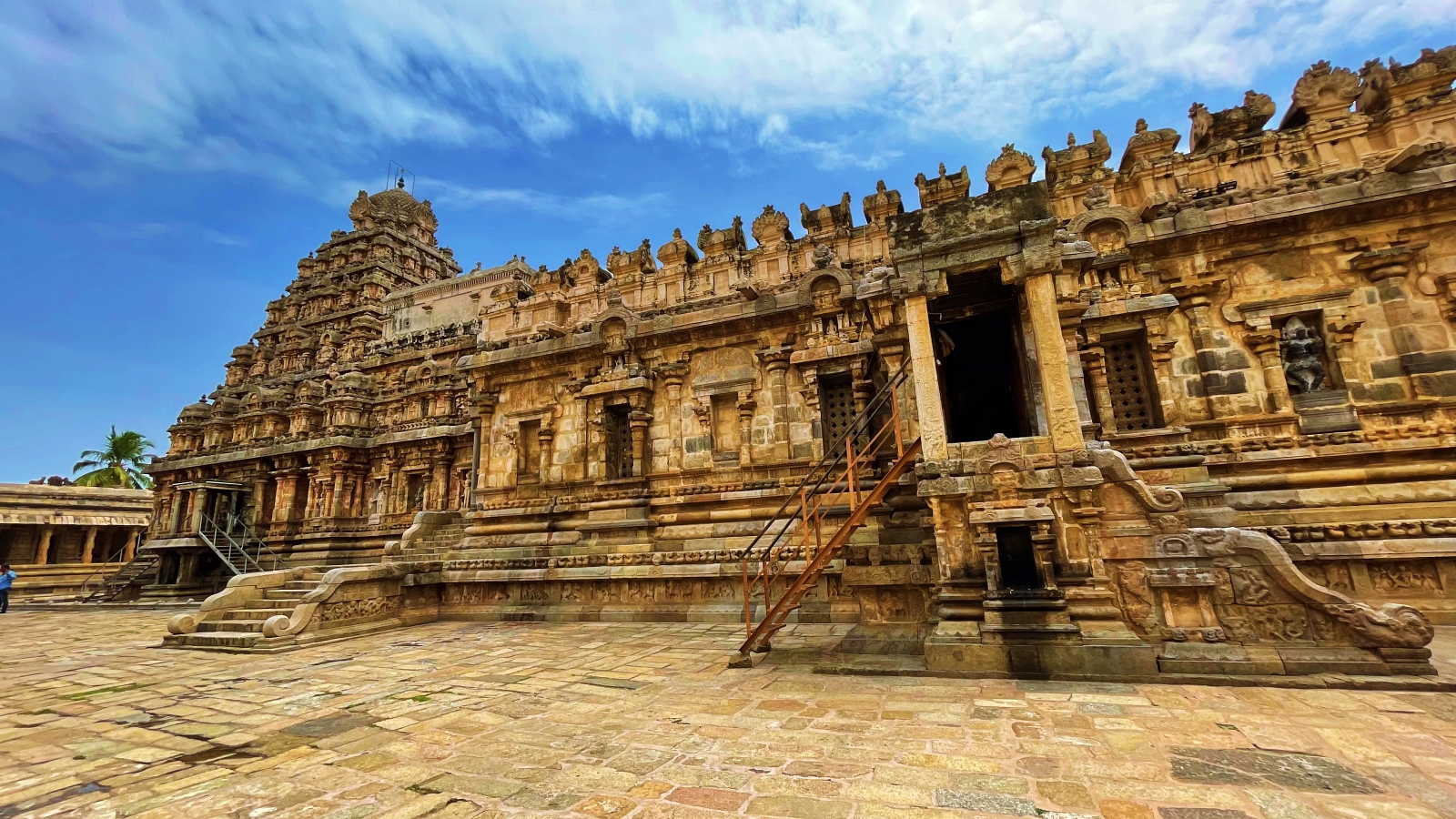
Many fine and wonderful miniature sculptures adorn its walls and pillars, many of them with optical illusions. The fabulous workmanship is easy to observe, and visitors can appreciate the temple’s beauty without neck-craning heights. In conclusion, Darasuram is a must-visit site for anyone interested in South Indian history, culture, and architecture. Its fascinating legend, intricate carvings, and optical illusions make it a unique and unforgettable experience.
Architecture of the Airavatesvara Temple
The temple stands as a breathtaking masterpiece of Dravidian architecture, boasting intricate carvings and sculptures that leave one in awe. Its main shrine reveres the mighty Lord Shiva, while within the temple complex, one can find sacred shrines devoted to the divine Goddess Parvati and a host of other celestial beings. The towering vimana, adorned with meticulous carvings of gods and goddesses, reaches towards the heavens as if beckoning the divine themselves. As one gazes upon the temple’s outer walls, they are greeted by a mesmerizing display of elaborate sculptures, each one telling a vivid tale from the vast tapestry of Hindu mythology.
The Chariots and Vimanas
The mighty Cholas, renowned for their architectural prowess, constructed a multitude of magnificent Hindu temples throughout their vast empire. Among these awe-inspiring structures, four stood as grand complexes adorned with majestic stone vimanas. The Airavatesvara temple, a jewel among these four, emanates an aura of divine splendour.
The remaining three temples, each a testament to the Chola dynasty’s grandeur, are the resplendent creations of Rajaraja I in Thanjavur, the awe-inspiring marvels crafted by Rajendra I in Gangaikonda Cholapuram, and the architectural marvels erected by the later era Chola king, Kulottunga II, in Tribuvanam. These temples, steeped in history and architectural brilliance, stand as enduring symbols of the Chola dynasty’s indomitable spirit and unwavering devotion to their Hindu heritage.
Airavatesvara temple was completed in the year 1166 CE. Its square-plan design stands as a testament to the architectural brilliance of its time. As we venture into its hallowed grounds, we are greeted by the surviving inner courtyard, a sight to behold. Stretching across almost six stacked squares, it spans an impressive 35 meters on each side, creating a vast expanse measuring approximately 107 meters by 70 meters. But the wonders do not end there, for beyond the confines of the main temple courtyard lie the Nandi mandapa and the stambha, standing proudly in alignment with the temple’s east-west axis. These structures, though separate, are intrinsically linked to the temple’s magnificence, enhancing its grandeur and majesty.
The temple sanctum is a grand structure with walls so thick that they stand tall, reaching a height of 24 meters. This 12-meter-sided square is adorned with the vimana superstructure, adding to its awe-inspiring presence, towering above all else at a staggering 79 feet. Unlike its counterparts, the Thanjavur big temple and the Gangaikonda Cholapuram temple, the temple sanctum does not boast an immediate circumambulatory path around its sacred space. Instead, this path gracefully winds its way outside, within the enchanting courtyard, inviting devotees to embark on a spiritual journey.
Connected to the sanctum garbha griya is the mukha-mandapa, a place of divine connection and reverence. This sacred space is bridged by the ardha-mandapa, a structure supported by pillars and guarded by two colossal dvarapalas. These guardians stand tall, their presence exuding strength and protection. And then, there is the maha-mandapa, a grand rectangle measuring approximately 24 meters by 18 meters. Within its vast expanse, six rows of mighty pillars stand, a testament to the architectural brilliance that surrounds them. A total of forty-eight pillars, each one a symbol of grace and beauty, supporting the very essence of this sacred space.
In this dramatic realm, the temple sanctum stands as a testament to human ingenuity and devotion. Its towering walls and intricate structures beckon all who seek solace and enlightenment. Step into this realm of divinity, where every inch is crafted with precision and every corner holds a story waiting to be discovered. As we venture towards the eastern side of the majestic maha-mandapa, we encounter the awe-inspiring agra-mandapa, also known as the Rajagambhiran-tiru-mandapam, named after the illustrious king himself. It is shaped like a majestic chariot, complete with stone horses and wheels. Its design, reminiscent of the Nritta-sabha, the vibrant community dance hall of the revered Chidambaram temple, and the resplendent Konark Sun Temple near Puri, Odisha, is a sight to behold.
Singing steps
The majestic Agra Mandapa boasts an exquisite square porch measuring 7 meters (23 ft) on each side. Its steps, adorned with intricate carvings, gracefully span from east to west, inviting visitors to ascend with a sense of awe. Positioned on the eastern side, just beyond the main podium, lies the extraordinary Bali-Pitham. This remarkable feature stands out for its meticulously crafted balustraded steps, which possess a truly enchanting quality. As one treads upon them, a melodious symphony resonates, filling the air with ethereal notes. It is no wonder, then, that these steps have earned the name of the Singing Steps.
Many Sculptures
This temple, my friends, is a veritable treasure trove of art and architecture, a sight to behold! Its exquisite stone carvings are nothing short of awe-inspiring. Now, I must admit, this temple may not be as grand in size as the mighty Brihadeesvara Temple or the majestic Gangaikondacholapuram Temple, but mark my words, it surpasses them in sheer detail and intricacy. As you gaze upon its magnificent structure, you cannot help but be captivated by the elegant elevation and perfectly proportioned units. Sculptures, my dear companions, dominate the very essence of this architectural marvel. And do you see that Balipitha? It stands proudly, its pedestal adjacent to a small shrine housing a divine image of none other than Ganesha himself.
But wait, there is more! The stories of the sixty-three Shaiva Bhakti saints, known as Nayanars, are etched into the very fabric of this temple. These tales, my friends, can be found within the sacred pages of the Periya Purana by the esteemed Sekkilar. As you wander along the base of the main temple, your eyes will feast upon the reliefs that narrate these captivating stories. And let us not forget the outer walls of the main sanctum, adorned with sculpture niches. Five on each side, with the middle one on each side standing taller and prouder than its companions. Within these niches, the divine Hindu deities come to life, each one more magnificent than the last. And in the middle, my dear companions, Shiva himself reveals his many aspects, a true testament to his divine power.
Countless Inscriptions
The temple is adorned with countless inscriptions that whisper tales of ancient glory. Among these sacred engravings, one stands out, chronicling the grand renovation of the shrines by none other than Kulottunga Chola III himself. Prepare to be astounded as you gaze upon the north wall of the verandah, a mesmerizing sight consisting of not one, not ten, but a staggering 108 sections of inscriptions. Each of these sections holds within its grasp the name, description, and image of the revered 63 Saivacharya, those holy saints of Saivism. Their lives, their triumphs, their very essence captured in stone, forever etched in the annals of time.
The other treasures that grace this hallowed sanctuary are the 108 Devara Othuvars, those celestial beings who once sang in unison within these sacred walls during the reign of Raja Raja II. Their voices, like ethereal melodies, filled the air, resonating with divine harmony and captivating all who were fortunate enough to bear witness. And as if that were not enough, cast your eyes upon the exquisite sculptures that adorn this sacred abode. Here, the river goddesses themselves come to life, their beauty and grace immortalized in stone. Cauvery, Ganges, Yamuna, Godavari, and Narmada, their presence a testament to the sacredness of water, the lifeblood that sustains us all.
In the grandeur of the gopura, a remarkable inscription unveils a captivating tale. It recounts the triumphant journey of Emperor Rajadhiraja Chola I, who, after vanquishing the Western Chalukya king Someshwara I and his valiant sons Vikramaditya VI and Someshwara II, brought forth a sacred image from the ancient city of Kalyani, once known as Kalyanapura. This awe-inspiring act of conquest and reverence forever etched in history.
These inscriptions hold a profound significance, not only in their historical accounts but also in their ability to identify the remnants of long-forgotten monuments. Take, for instance, the eastern gopurum, adorned with niches that once housed magnificent sculptures. The inscriptions adorning these niches serve as a testament to the artistry and craftsmanship of the past, meticulously labelling each sculpture within. Alas, the ravages of time have taken their toll, leaving most of these sculptures shattered or lost to the annals of history. Yet, even in their fragmented state, they whisper tales of a bygone era, evoking a sense of wonder and longing for the beauty that once graced these sacred grounds.
Let us not merely see these inscriptions as mere words etched in stone, but as portals to a world long forgotten. They are the threads that connect us to our ancestors, reminding us of the indomitable spirit that drove them to create and conquer. May we, too, be inspired by their legacy, and strive to preserve and honor the remnants of their once majestic creations.
The inscriptions indicate that it had the following sculptures:
- Northern face: Adi Chandesvara, Gangadevi, Tumburu Nardar, Vaisravana, Chandra, Maha Sata, Nagaraja, Vayu
- West: Devi, Rudrani, Vaishnavi, Brahmi, Varunani, Nandidevar, Periyadevar, Santyatita Sakti, Santa devi, Vidya Sakti, Pratishta Sakti, Nivarti Sakti
- Southern face: Daksha Prajapati, Yamuna devi, Rati, Kamadeva
- East: Agni deva, Agastya, Sri devi, Durga devi, Devendran, Padma Nidhi, Surya, Subrahmanya, Kshetrapala, Sarasvati, Visvakarma, Isana
Rituals and Worship
The Airavateswara temple, a sacred haven of devotion, pulsates with life as it embraces the faithful in its daily rituals and ceremonies. As the first rays of the sun grace the horizon, the temple gates swing open, beckoning devotees to immerse themselves in prayer and perform sacred rituals throughout the day. At the heart of this divine sanctuary stands the majestic Lord Shiva, adorned with a resplendent array of offerings. Fragrant flowers, succulent fruits, and holy water are delicately placed before the deity, a testament to the unwavering devotion of the faithful.
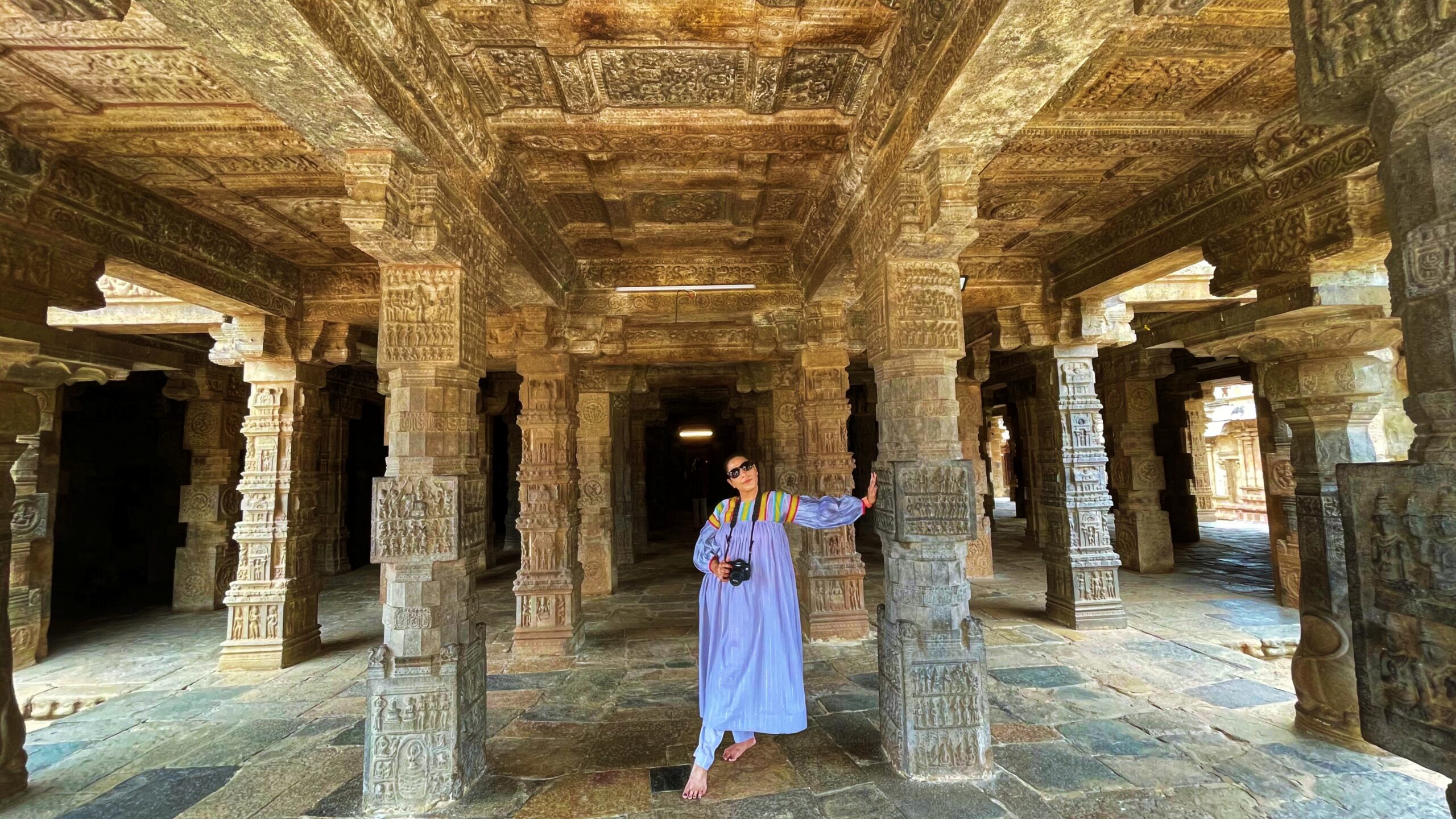
With utmost reverence, the temple priests orchestrate elaborate rituals, their every movement a graceful dance of devotion, as they offer heartfelt prayers to the divine. But the journey of devotion does not end there. The devoted souls who flock to this sacred abode have the privilege of partaking in extraordinary ceremonies. One such ceremony is the abhishekam, the ritual bathing of the deity, where the purest waters cascade upon the divine form, cleansing and purifying both body and soul. Another enchanting ceremony is the archana, where prayers are tenderly offered with vibrant flowers and sacred chants, creating an ethereal symphony that resonates through the hallowed halls.
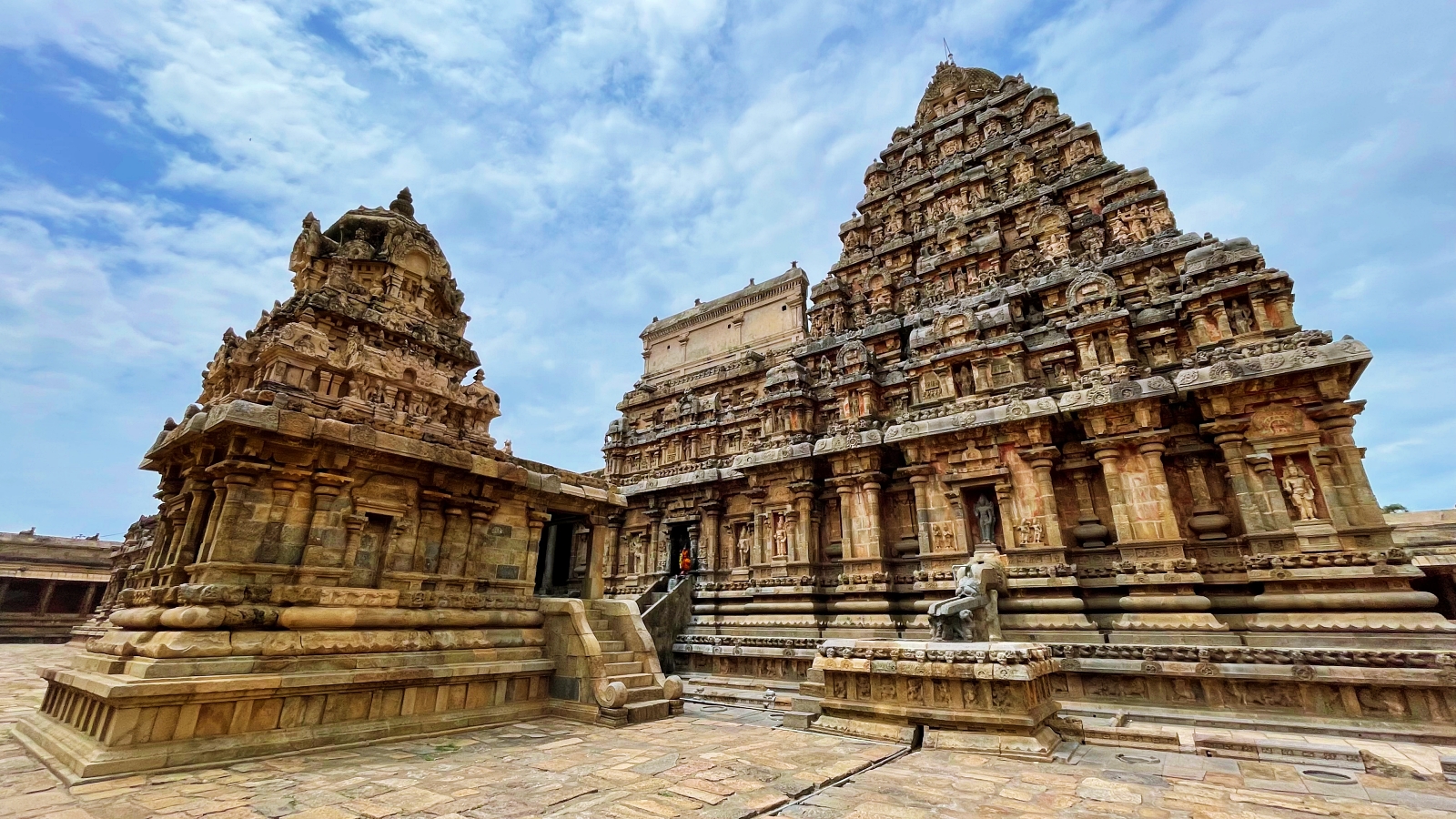
Within the embrace of this temple, the mundane world fades away, and devotees are transported to a realm where the divine and mortal intertwine. The air is thick with anticipation, as each soul yearns to connect with the divine presence that permeates every inch of this sacred space. In this dramatic tapestry of devotion, the Airavateswara temple stands as a testament to the unwavering faith of its devotees. It is a sanctuary where the divine and human realms converge, where prayers are whispered, and souls are uplifted. Step into this ethereal realm, and let the temple’s vibrant rituals and ceremonies ignite the flame of devotion within your heart.
Festivals
The Airavateswara temple, renowned for its majestic festivals, possesses an irresistible allure that beckons devotees from every corner of Tamil Nadu. Amongst these grand celebrations, the annual Brahmotsavam festival reigns supreme, casting its enchanting spell for an awe-inspiring ten days. Picture this: the deities, adorned in resplendent attire, emerge from their sacred abode, embarking on a majestic procession atop a myriad of ornate vehicles. As they traverse the temple grounds, the air resonates with the harmonious melodies of music and the graceful movements of dancers, captivating the hearts of all who bear witness. But wait, there’s more! Yet another momentous occasion – Mahashivaratri.
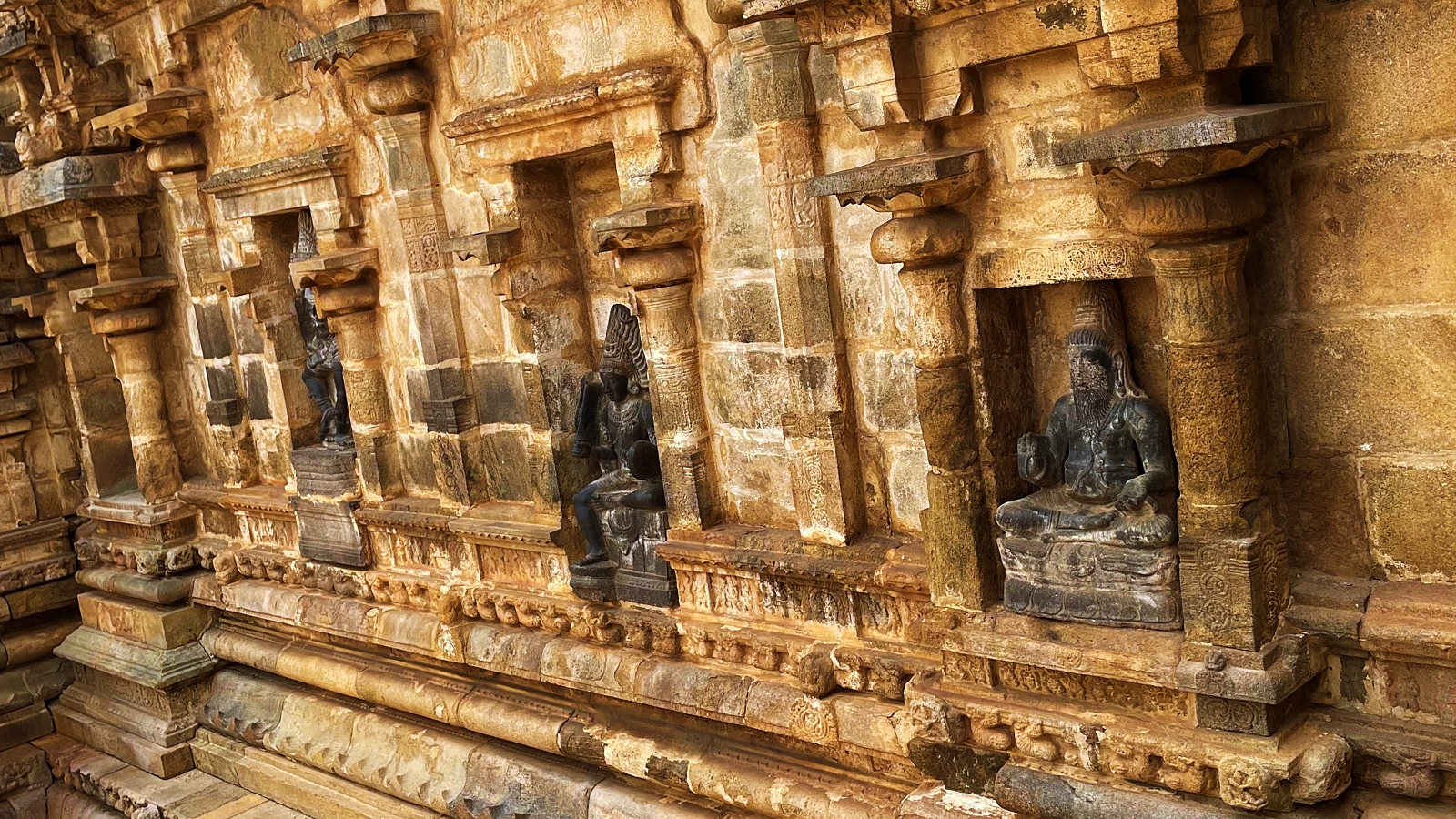
This extraordinary festival commemorates the divine union of Lord Shiva and the radiant Goddess Parvati. Devotees, driven by their unwavering faith, embark on a spiritual journey, embracing fasting and offering fervent prayers throughout the night. The atmosphere is charged with an electric energy, as the temple becomes a sanctuary of devotion and reverence. In this hallowed place, where the divine and mortal realms intertwine, the Airavatesvara temple stands as a testament to the profound connection between humanity and the divine. Its festivals, like shimmering jewels adorning the crown of Tamil Nadu, beckon all who seek solace, enlightenment, and a glimpse into the mystical wonders of the universe.
Visiting the Airavatesvara Temple
The Airavateswara temple is located in Kumbakkonam, a prominent temple town in Tamil Nadu. It is easily accessible by road and rail. The temple is open to visitors throughout the year and welcomes devotees from all walks of life. The best time to visit the temple is during the festivals when the entire complex is adorned with lights and decorations. In conclusion, the Airavateswara temple in Kumbakkonam is a must-visit for anyone interested in South Indian architecture and Hindu mythology. Its rich history, stunning architecture, and vibrant festivals make it a truly remarkable place. Whether you are a devout worshipper or a curious traveller, a visit to the Airavateswara temple is sure to leave you awe-inspired and spiritually uplifted.



